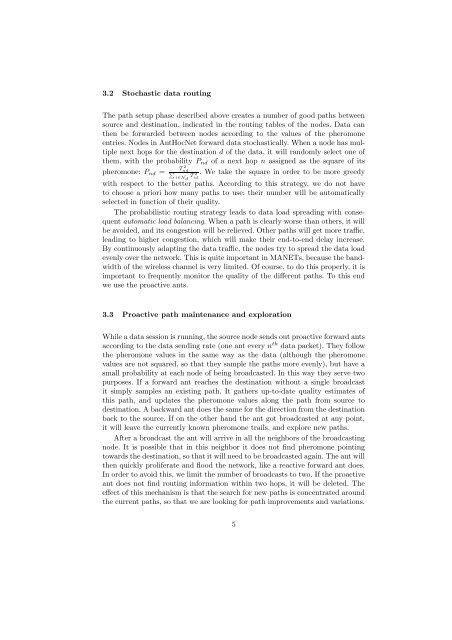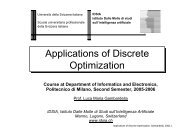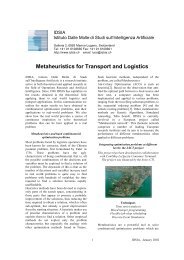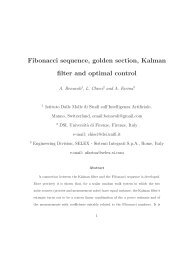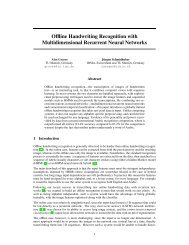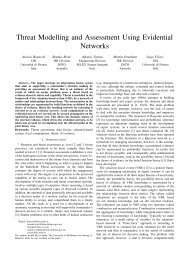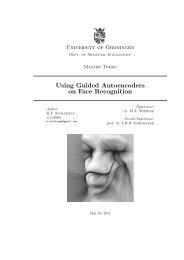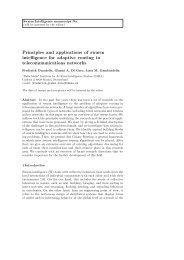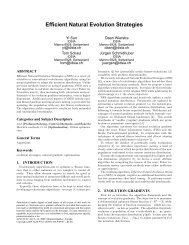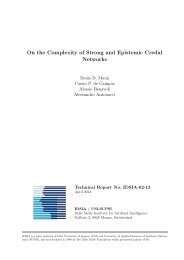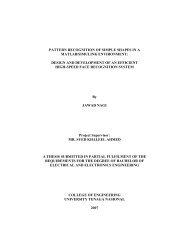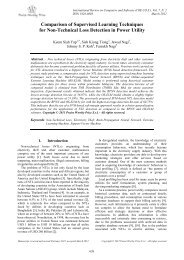AntHocNet: an Ant-Based Hybrid Routing Algorithm for ... - CiteSeerX
AntHocNet: an Ant-Based Hybrid Routing Algorithm for ... - CiteSeerX
AntHocNet: an Ant-Based Hybrid Routing Algorithm for ... - CiteSeerX
You also want an ePaper? Increase the reach of your titles
YUMPU automatically turns print PDFs into web optimized ePapers that Google loves.
3.2 Stochastic data routing<br />
The path setup phase described above creates a number of good paths between<br />
source <strong>an</strong>d destination, indicated in the routing tables of the nodes. Data c<strong>an</strong><br />
then be <strong>for</strong>warded between nodes according to the values of the pheromone<br />
entries. Nodes in <strong><strong>Ant</strong>HocNet</strong> <strong>for</strong>ward data stochastically. When a node has multiple<br />
next hops <strong>for</strong> the destination d of the data, it will r<strong>an</strong>domly select one of<br />
them, with the probability P nd of a next hop n assigned as the square of its<br />
pheromone: P nd =<br />
T<br />
∑<br />
2 nd<br />
i∈N T 2<br />
d id<br />
. We take the square in order to be more greedy<br />
with respect to the better paths. According to this strategy, we do not have<br />
to choose a priori how m<strong>an</strong>y paths to use: their number will be automatically<br />
selected in function of their quality.<br />
The probabilistic routing strategy leads to data load spreading with consequent<br />
automatic load bal<strong>an</strong>cing. When a path is clearly worse th<strong>an</strong> others, it will<br />
be avoided, <strong>an</strong>d its congestion will be relieved. Other paths will get more traffic,<br />
leading to higher congestion, which will make their end-to-end delay increase.<br />
By continuously adapting the data traffic, the nodes try to spread the data load<br />
evenly over the network. This is quite import<strong>an</strong>t in MANETs, because the b<strong>an</strong>dwidth<br />
of the wireless ch<strong>an</strong>nel is very limited. Of course, to do this properly, it is<br />
import<strong>an</strong>t to frequently monitor the quality of the different paths. To this end<br />
we use the proactive <strong>an</strong>ts.<br />
3.3 Proactive path mainten<strong>an</strong>ce <strong>an</strong>d exploration<br />
While a data session is running, the source node sends out proactive <strong>for</strong>ward <strong>an</strong>ts<br />
according to the data sending rate (one <strong>an</strong>t every n th data packet). They follow<br />
the pheromone values in the same way as the data (although the pheromone<br />
values are not squared, so that they sample the paths more evenly), but have a<br />
small probability at each node of being broadcasted. In this way they serve two<br />
purposes. If a <strong>for</strong>ward <strong>an</strong>t reaches the destination without a single broadcast<br />
it simply samples <strong>an</strong> existing path. It gathers up-to-date quality estimates of<br />
this path, <strong>an</strong>d updates the pheromone values along the path from source to<br />
destination. A backward <strong>an</strong>t does the same <strong>for</strong> the direction from the destination<br />
back to the source. If on the other h<strong>an</strong>d the <strong>an</strong>t got broadcasted at <strong>an</strong>y point,<br />
it will leave the currently known pheromone trails, <strong>an</strong>d explore new paths.<br />
After a broadcast the <strong>an</strong>t will arrive in all the neighbors of the broadcasting<br />
node. It is possible that in this neighbor it does not find pheromone pointing<br />
towards the destination, so that it will need to be broadcasted again. The <strong>an</strong>t will<br />
then quickly proliferate <strong>an</strong>d flood the network, like a reactive <strong>for</strong>ward <strong>an</strong>t does.<br />
In order to avoid this, we limit the number of broadcasts to two. If the proactive<br />
<strong>an</strong>t does not find routing in<strong>for</strong>mation within two hops, it will be deleted. The<br />
effect of this mech<strong>an</strong>ism is that the search <strong>for</strong> new paths is concentrated around<br />
the current paths, so that we are looking <strong>for</strong> path improvements <strong>an</strong>d variations.<br />
5


